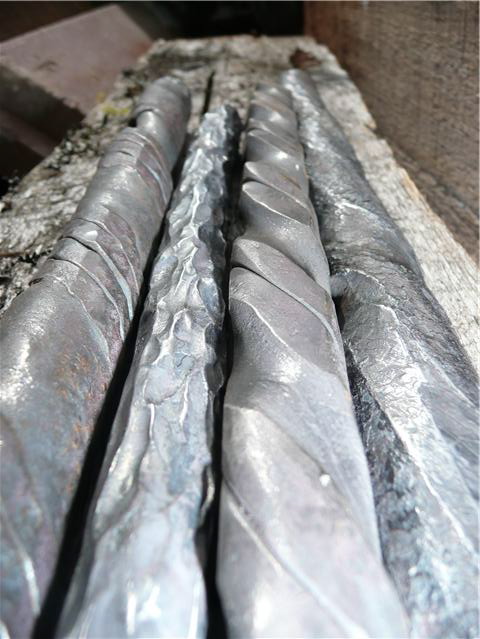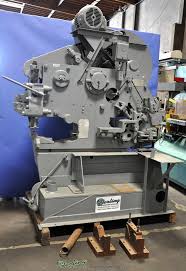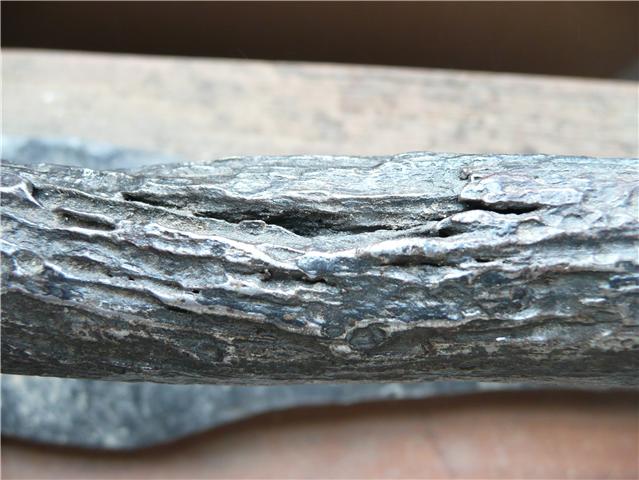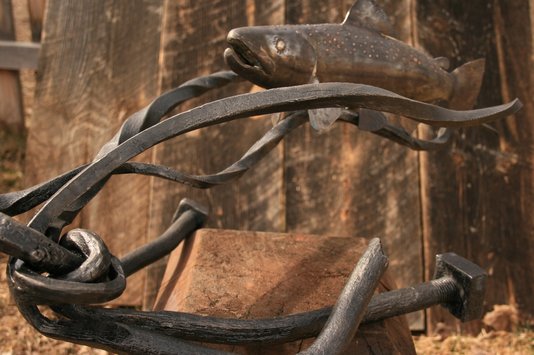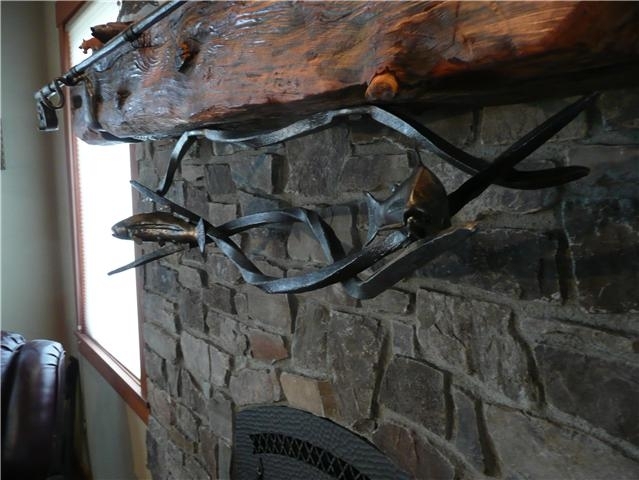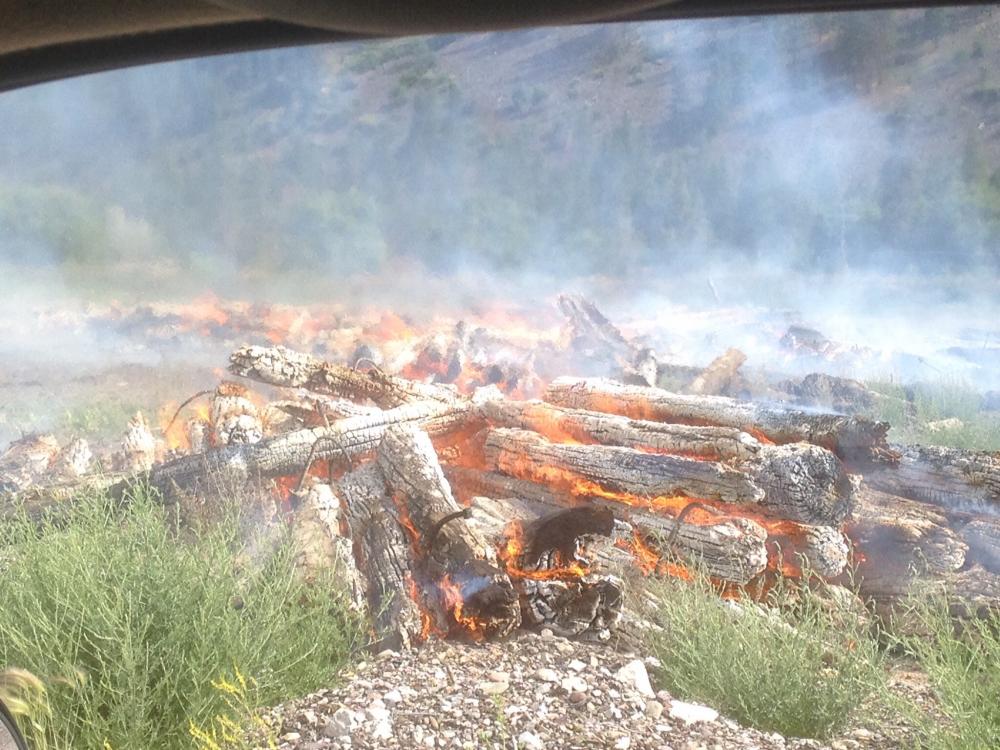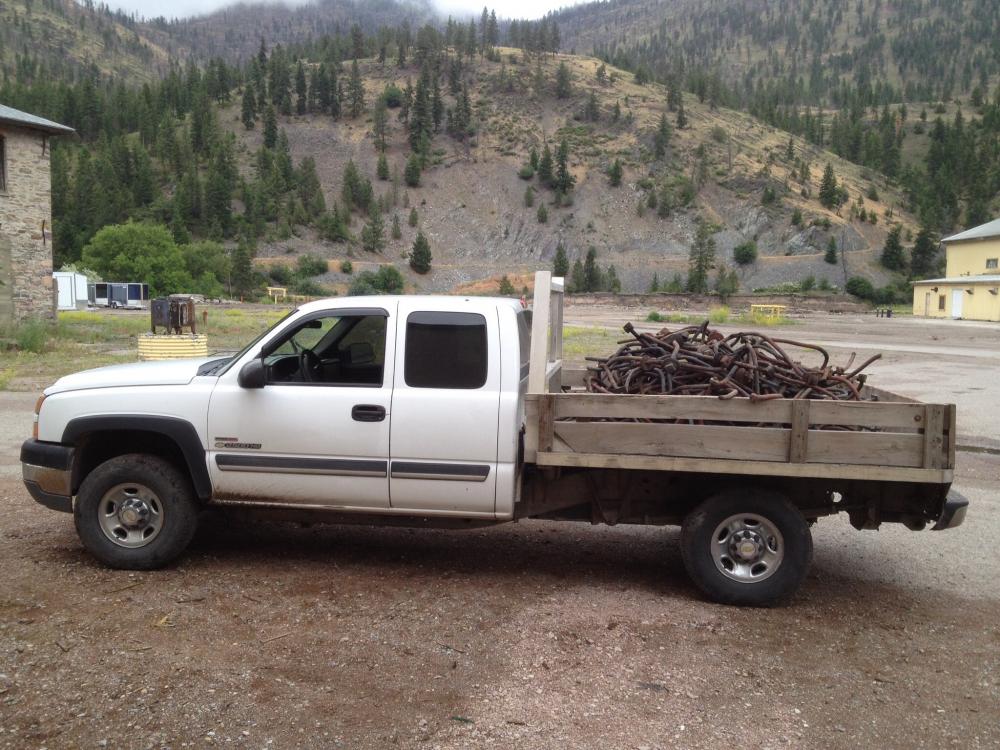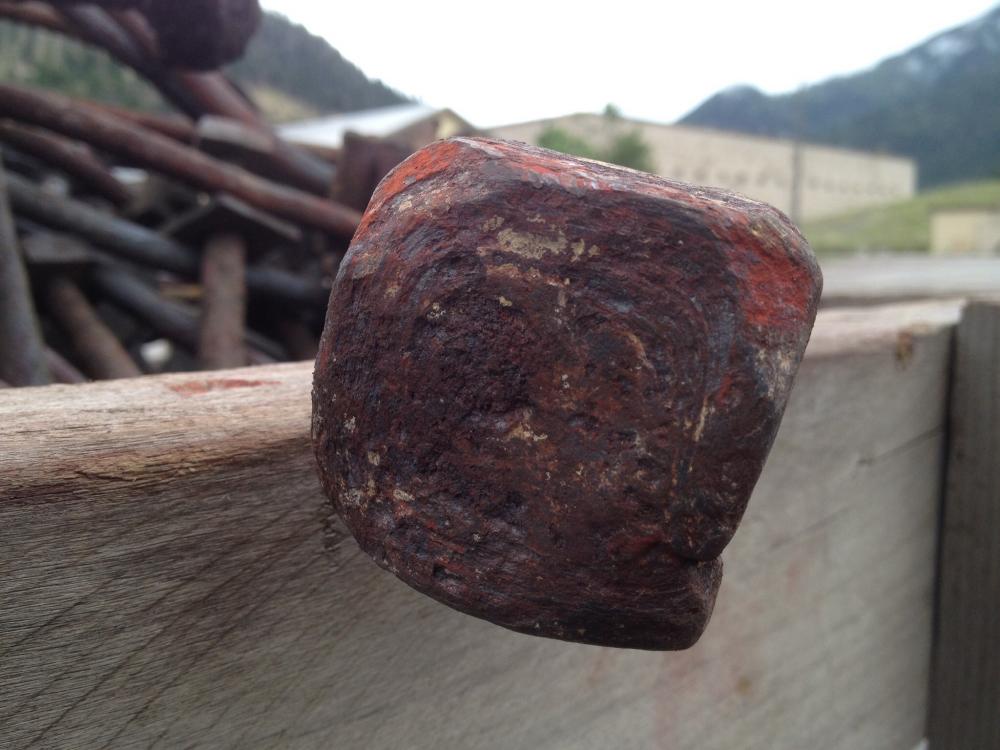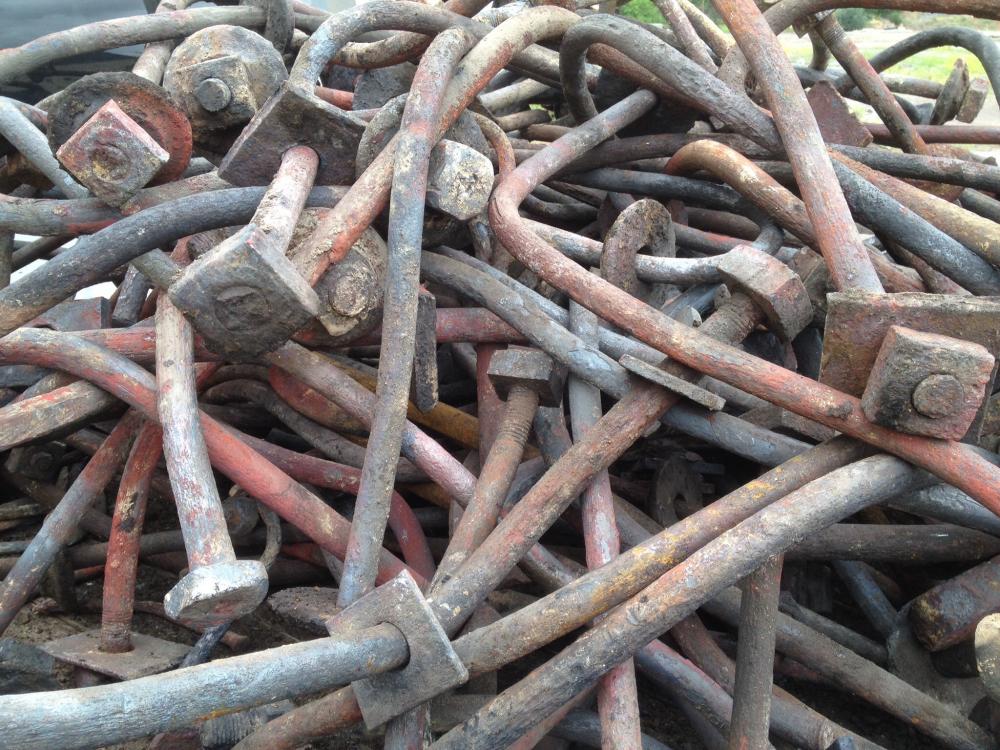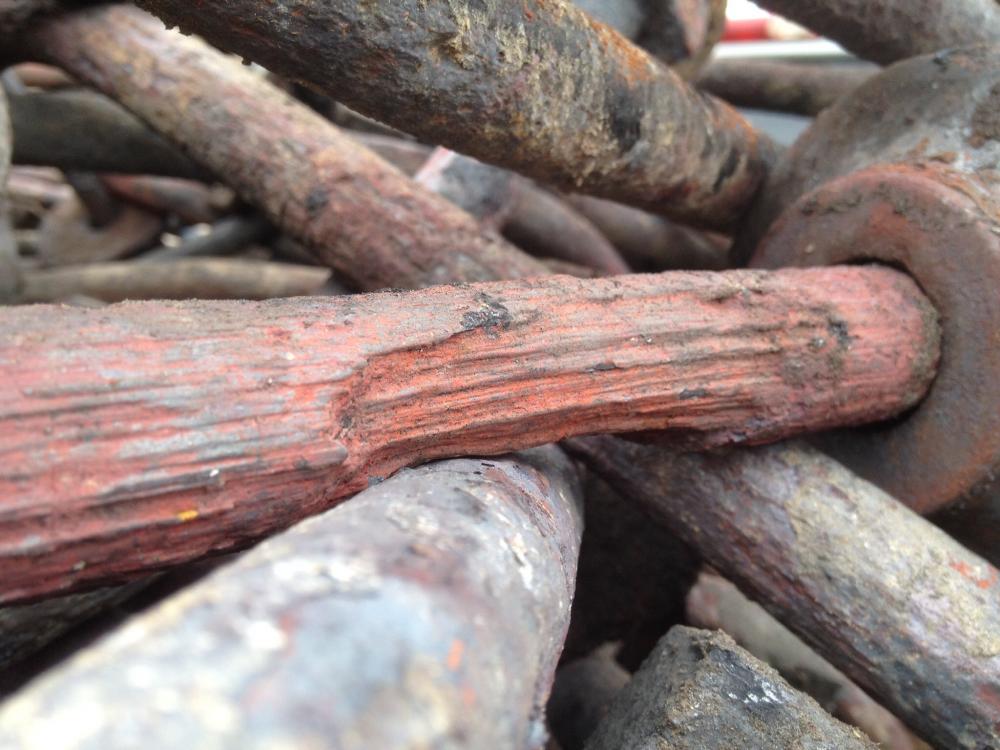-
Posts
307 -
Joined
-
Last visited
Content Type
Profiles
Forums
Articles
Gallery
Downloads
Events
Everything posted by Wroughton
-
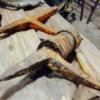
Candy cane failure
Wroughton replied to Michael Cochran's topic in Blacksmithing, General Discussion
Michael, As Dogsoldat said, you're into an interesting realm and while it may not be exactly what you're looking for it'll blow them away. Forged tubing, pipe, angle iron thats folded and then twisted makes for a very cool effect. Forged again after twisting and its something else. You might try jump welding stainless steel (jump weld- jump over to your welder) in long beads down a pipe or square tubing. In the middle of the tube or down the coners, doesn't matter. The first picture has two examples of twisted pipe/tubing. Forge into a figure 8 in cross section. Flatten from the vertical, twist tight, forge to your liking. The second picture is slitted 1" hot rolled steel with 1/4" x 2" copper upset on its edge and then twisted together at heat. Someone else can name that technique. Linear twisted rivet? -

Can Silver and Steel be combined to create a viable blade
Wroughton replied to FusionShardProductions's topic in Knife Making
You're trekking through new territory in the manufacturing side of bladesmithing too. You need to think about ways to inlay a heavy band of silver in a steel blade if you want the bragging rights of having silver on the blade. If it's just for better conductivity, then copper would probably do the trick. There very well may be an exotic alloy that will hold an edge AND conduct electricity similar to copper. If there is such an animal it's price per OZ may exceed the silver. good luck -
I found several suppliers with a quick google search. Buying from a knife making supply house will be your most expensive option other than Ebay. Amounts matter also. There are also manufacturers of 5160 in your state. Now, they'll laugh you out of the country if you tell them you want to by a 12" chunk but they can probably guide you to a local distributor if you ask. If I was looking for one piece, a trip to the local spring bender would be my first move.
-
Still a good premiss and a better idea for a blacksmith tv show. Survivor blacksmith. Probably a team event or the show would have to be shot in decades, instead of years. Better than Junkyard Wars but similar. Less contrived options, real power problems. Post apocalypse Dave Gingery from top to bottom. How long would it take to make a metal shop from a dead town? Yes, we need MacGyver AND the professor..... (new models of Ginger and Mary Anne appreciated also).
-

So why Blacksmith at all??
Wroughton replied to MAD MAX's topic in Blacksmithing, General Discussion
I'm sorry, but Smoothbore has the truth of it. The reasons for making things with your own skills and hands are plentiful and obvious. But you shouldn't feel defensive when a xxxxxxx shows his butt. -

They didn't have angle grinders in 1875...
Wroughton replied to Everything Mac's topic in Blacksmithing, General Discussion
You haven't a clue about what you're capable of until you have a slight inkling of how ALL processes work, new or old. Lessons in hand sawing, lag bolt driving and remodeling a submarine as good examples here in this thread. Good thoughts on economy of labor also. This is probably anyone's most valid concern. If it isn't then you're just mucking around. I can do most of my work by hand. Do I want to deliver said work in a month? OR A YEAR? Running around looking for a grinder for 5 minutes when a big cold chisel and sledge will knock that 1/2" bolt head off there in a whack is ......ignorance. Chiseling off 100, 1/2" bolt heads instead of using an impact wrench is ......stupid. Learn, I dare you. I triple dog dare you. In 500 years will some futuristic smith be rebuilding ancient Miller mig welders, arguing thier virtues, and welding instead of using his 3D holographic printer? Most likely. -

Hydraulic Iron Works
Wroughton replied to Diays Creek Forge's topic in Machinery General Discussions
OSHA aside........way aside......look for old (pre hydraulic) mechanicals. Most parts are still supported for Buffalo and Wells. There are several outside suppliers that support the tooling. Most of those can notch and shear angle, notch plate, punch, shear flat bar and round and square stock. Fairly straightforward mechanics and as they were engineered for almost constant duty in a factory they hardly ever break down. A small ironworker, mechanical or hydraulic, can punch through double capacity if the metal is hot. Bigger punches actually being better for multiples as they won't heat up as fast. However, they're in the metal a very short time as it is. ok- Put your safety hats on. When you push the pedal it's too late to call it off, so know wth you're doing at that moment. Build guards for all attachments. Pedals usually are connected to more than one option. When you hit the punch on my mechanical IW the 3 inch angle cutter above it comes down too. It's the natural spot to put your fingers when you're getting too comfortable on the punch. The manual has a nice 3 inch bird mouth cut as it was setting there and the guard wasn't installed when I went to see it in action the first time. "here's your manual, sorry about that notch" Grease is cheap, parts aren't. My model here. -

SCRAP METAL PRICES - what gives ?
Wroughton replied to territorialmillworks's topic in Blacksmithing, General Discussion
Instead of big interest scrap businesses, visit fabrication/manufacturing shops for scrap. If they have work their scrap is piling up and as stated above, it's not worth kicking into the corner. Don't bug the big guys. Look for owner operators, bring a widget/gift/6pack. This should actually be a stellar time for getting your scrap on. Your metal suppliers will be offering good deals on remnant and scrap, mine are. Be prepared to make a decent offer on a large pile to turn heads. Paying $100 for a pile of scrap might make some of you faint but if you have enough stock to get you through a couple of years of forging it will be worth it. -

Does everyone have days like these?
Wroughton replied to HEAP of JEEP's topic in Blacksmithing, General Discussion
There's probably a joke in there for jeep guys too. Was it an AMC leaf spring you used for your material? A Willys leaf spring probably would have got up on the anvil and forged itself together. -

A practiced eye to help identify some wrought.
Wroughton replied to TimeToWaste's topic in Blacksmithing, General Discussion
Thank you Daswulf. I'm still practicing. No, I don't think the little stuff is an issue. In some places the big stuff isn't an issue, especially in the river. We have fast moving free stone streams that move and change the river bottom every year. Something you may be floating over in spring time is probably poking out in late summer. So iron out, along with engine blocks, road signs, tons of flip flops, draft horse shoes and whatever else (barbie edition shakespear fishing rod). -

A practiced eye to help identify some wrought.
Wroughton replied to TimeToWaste's topic in Blacksmithing, General Discussion
I find old bridge landings and mill sites, mines, RR stops and camps. Definitely easier to get permission out here for removing things but metal is a no brainer in a river known for its recreation. I now have the salvage rights for the timber still left near us, iron is a by blow. Most was tossed as garbage but there were some treasures. Swage block, broad axes and hoes, picks, hammers, double barrel percussion cap shotgun, yards of hand forged chain. Test the waters, I would guess that bureaucracy will get in the way and everyone will want you to pay them for a permit. Maybe talk to a salvage company? They may know how to proceed if you're just taking rusty iron. My permits were done through the water conservation district and EVERYONE has to sign off. Since we aren't technically using power equipment below the high water mark we were able to skirt around scrutiny from entities (Army Corps of Engs, DNRC) that would have probably charged a sizable lump and drug us through months/years of red tape. They still had to be contacted individually and sign off on the permit. We weren't hired to do the job so there's no expectations or goals to reach and no performance bond or other nonsense like that. The trout are forged and fabricated from mild steel but the "current" lines are all wroughton from the river. I left some of the wrapped and forge welded bold heads on some. -
So, how'd it go? Still stuck? I've done the same trick. It will score the flat sides on the guides but you've already done that so...... put a little pressure to the treadle and see if that kicks it out. The flat plates on either side of the cylinder are replaceable if its like mine. I've stuck mine this way a couple of times but usually its just a copper shim plate working its way out from behind the die. It may groan and spit oil but usually kicks out after a stutter or two. You can turn your plates around if they're scored bad. If that doesn't work you might try smacking the die the opposite way with something. I know it disappears up in the cylinder housing but you may be able to hit it (sending the die AWAY from the side the key is sticking into) with a big (BIG) punch. If it's loose from the key coming too far it might just fall out and drop the tup. I've had my Stryker for 11 years and I'm more than pleased with the capabilities of this little hammer. The oiler's crap and the factory die keys are too but it's basic message gets put to the metal very well. I'm chronically breaking down stock way bigger than the recommended 1" max size.
-

Today was a good day
Wroughton replied to Michael Cochran's topic in Blacksmithing, General Discussion
Hi, i would say your burning too rich still. Less loose flame (I like the term "dragons breath"). As soon as you pull the gas supply back and more air enters the DB will recede. Then u should have a neutral flame. You will have to adjust as the firebox heats up. -

How do you spot wrought iron
Wroughton replied to GottMitUns's topic in Blacksmithing, General Discussion
Thomas, Out of the river and timbers as the dam was taken apart near my shop (300yds) . A large portion were collected after huge piles of junk timbers were burned by the state to reduce the pile going to the land fill. -

How do you spot wrought iron
Wroughton replied to GottMitUns's topic in Blacksmithing, General Discussion
Grainy. This is 1880s stock from a timber dam. Here's a 2 1/4" bolt head with wrapped and forge welded head. Merchant bar stock. It's very coarse. Almost all wagon tires are wrought. Usually refined so they don't always show the best grain. Spark testing, while not definitive (for the naysayers), can be helpful. Wrought has a duller red spark that usually will not split and sparkle. It can hard to spot the forge weld on production tires but frontier fixes are fairly apparent. I have one that is quite patched and probably a scrap pile build as it would be hard to believe someone would have bothered to keep fixing it. -

How do you spot wrought iron
Wroughton replied to GottMitUns's topic in Blacksmithing, General Discussion
-
Sorry to hear that Ausfire. For straight beeswax you need to be pretty hot. The viscosity needs to be like hot oil and you should wipe off the excess. For small items i heat and rub solid wax directly. If I have to cover some serious ground i melt a pint or so and brush on hot metal. I used to used paste wax but it's not as hard of a finish. I also would mix in black shoe polish to darken iron, but dirty, unfiltered/unstrained beeswax seems to darken better. Smells a world better too vs paste wax. I like its finish better than oils also.
-
Nice, looks like a relative of my wall tent stoves. I've always used normal stovepipe and connections....hmmmm
-
Most beekeepers have some nasty beeswax that's half bee parts and other detritus. Especially the hobby keepers. Your metal couldn't care less if it's not candle grade wax. About a $1 a lb or better yet, free. Its almost always has a dark tint to it too which can help darken the metal.
-
It's a door stop. I think someone suggested using it for setting small rivets and such. Large RR track is always the best first option for being without anvil. I say this because it seems like the easiest to find. Start forging.....then search for bigger blocks of steel to upgrade. Scrap yards, large equipment shops, OLD fab shops. For all of those suggestions....the older and more run down the better. Big block of steel + large dimension pipe or tubing filled and tamped with earth or gravel, and a big brake drum welded together and you are off to the races. Scrap is in the tank right now so it's a good time to look. Don't go dressed as Gandalf or a blacksmith of olde. You won't impress these people. The big flat one is my first and possibly my fav. It's about 170lbs and 4" thick. AR plate or T1, I can't remember. The rebound would amaze most. The other is mild steel I believe. Pretty soft but has a great rebound too and it doesn't mar my hammers. Great for detail work with different radiuses on each edge. I probably went too long without a proper anvil to be a dyed in the wool advocate. Now I have the real deal all over but don't use as much as my shop made models. Only when I need to use a spring swage or cutoff tool usually.
-

What weird animals have been in your shop
Wroughton replied to Glenn's topic in Blacksmithing, General Discussion
I guess i shouldn't be surprised theres more than one shop bear story. Some of us tend to live in the BOONIES. Mine came around the corner of the shop while some after work beers were being had. Lots of swearing and spilt beer later the bear was swimming the river and away. Marmots (our groundhog) are the worst and have excavated large chunks under my shop and surround buildings. The answer for both problems were my canine shop employees, Dewey and "the fuzz". -
I would like to second the notion. Very nice portfolio piece FF!
- 17 replies
-
- Hand forged
- Ballnuts
-
(and 5 more)
Tagged with:
-

Relationships and their place. Push Vs. Pull
Wroughton replied to rockstar.esq's topic in The Business Side of Blacksmithing
To fee, or not to fee, that is the question. Keep blogging and I'll keep learning. Thank you sir. -

Relationships and their place. Push Vs. Pull
Wroughton replied to rockstar.esq's topic in The Business Side of Blacksmithing
Always a treat Rockstar. Even if it made my stomach churn. It's like you are sitting on my shoulder. I had a run in with a giant multistate G.C. (One Cali job is in the 50m range) recently and your points resounded time after time. I will never do work with them again and i know they wont be used again by the architect or client either. After defining the bid AND our scope within the job for them they continually added road blocks to stall the job from being completed In a very poorly veiled attempt to drag out the work. Disclaimers galore, from on site workplace safety to unknowns on plans. Communication, other than heaps of digital plans, like spam, was poor and without substance until a heated meeting with the architects and client which fixed things to a very small degree. Yeeesh, almost started a rant i couldn't stop! I agree wholeheartedly Rockstar. -

ironwork of different cultures
Wroughton replied to dontpaymenomind's topic in Blacksmithing, General Discussion
Not just iron but great nonetheless. Metal techniques for craftsmen By Oppi Untracht

